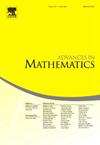Edge-disjoint cycles with the same vertex set
IF 1.5
1区 数学
Q1 MATHEMATICS
引用次数: 0
Abstract
In 1975, Erdős asked for the maximum number of edges that an n-vertex graph can have if it does not contain two edge-disjoint cycles on the same vertex set. It is known that Turán-type results can be used to prove an upper bound of . However, this approach cannot give an upper bound better than . We show that there is an absolute constant t and some constant such that for each , every n-vertex graph with at least edges contains k pairwise edge-disjoint cycles with the same vertex set, resolving this old problem in a strong form up to a polylogarithmic factor. The well-known construction of Pyber, Rödl and Szemerédi of graphs without 4-regular subgraphs shows that there are n-vertex graphs with edges which do not contain two cycles with the same vertex set, so the polylogarithmic term in our result cannot be completely removed.
Our proof combines a variety of techniques including sublinear expanders, absorption and a novel tool for regularisation, which is of independent interest. Among other applications, this tool can be used to regularise an expander while still preserving certain key expansion properties.
求助全文
约1分钟内获得全文
求助全文
来源期刊

Advances in Mathematics
数学-数学
CiteScore
2.80
自引率
5.90%
发文量
497
审稿时长
7.5 months
期刊介绍:
Emphasizing contributions that represent significant advances in all areas of pure mathematics, Advances in Mathematics provides research mathematicians with an effective medium for communicating important recent developments in their areas of specialization to colleagues and to scientists in related disciplines.
 求助内容:
求助内容: 应助结果提醒方式:
应助结果提醒方式:


